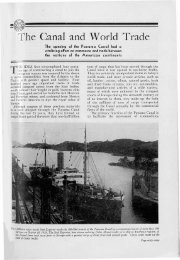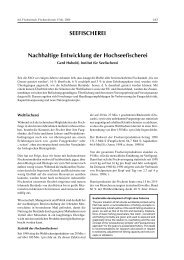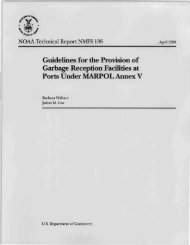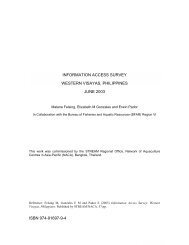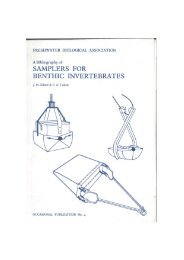FULL TEXT PDF - Freshwater Biological Association
FULL TEXT PDF - Freshwater Biological Association
FULL TEXT PDF - Freshwater Biological Association
Create successful ePaper yourself
Turn your PDF publications into a flip-book with our unique Google optimized e-Paper software.
OSOLLATORIA BLOOM IN LOCH LEVEN 203<br />
DEVELOPMENT AND COLLAPSE OF AN OSCILLATORIA BLOOM<br />
IN LOCH LEVEN DURING JULY 1994<br />
JANET A. ARMSTRONG, IAN R. FOZZARD AND ROBERT J. SARGENT<br />
(Dr J. A. Armstrong, I. R. Fozzard and R. J. Sargent, Forth River<br />
Purification Board, Clearwater House, Heriot Watt Research Park,<br />
Avenue North, Riccarton, Edinburgh EH 14 4AP, Scotland.)<br />
Introduction<br />
Loch Leven lies in a glacial depression 35 kilometres north of Edinburgh,<br />
Scotland. It has a large surface area, 13.3 km 2 , but is generally shallow<br />
with a mean depth of 3.9 metres, although there are two deeper "holes"<br />
where the depth reaches 25 metres. Land use in the 145 km 2 catchment<br />
draining to the loch is predominantly arable farming, with some rough<br />
grazing in the headwaters and with three small towns close to the loch.<br />
The physical characteristics of Loch Leven are fully described by Smith<br />
(1974); it is a National Nature Reserve, a Site of Special Scientific<br />
Interest, and is cited under the Ramsar Convention as a wetland site of<br />
international importance.<br />
Because of its lowland situation the loch is naturally productive and<br />
algal blooms are common. Bailey-Watts et al. (1987) estimated the<br />
annual load of phosphorus entering the loch from diffuse sources in the<br />
catchment at 26 kilograms per day. Over the past ten years, point-source<br />
emissions of phosphorus have been steadily reduced from 32 kg per day<br />
to around 9 kg per day in 1994. However, there is a legacy of<br />
historically high phosphorus loadings held in the loch sediment, which<br />
can be released into the loch water under certain conditions.<br />
In 1992 a particularly severe bloom of the blue-green algae Anabaena<br />
and Microcystis caused much publicity and considerable damage to the<br />
world-famous fishery in Loch Leven. As a result of this the Forth River<br />
Purification Board (FRPB) decided to supplement its spot-sampling of the<br />
loch and its tributaries with a buoy, moored in the loch and able to<br />
continuously monitor basic water quality parameters. The buoy was<br />
deployed in May 1994 and produced detailed data on the condition of<br />
the loch through the development and subsequent collapse of a bloom<br />
of another blue-green alga, Oscillatoria. This article briefly describes<br />
some important features and gives our initial thoughts on events in the<br />
loch during this period.
204 J. A. ARMSTRONG, I. R. FOZZARD AND R. J. SARGENT<br />
Sampling the loch<br />
Sampling has been carried out in conjunction with Scottish Natural<br />
Heritage and the NERC Institute of <strong>Freshwater</strong> Ecology. During 1994,<br />
weekly spot-sampling of open water sites on Loch Leven took place from<br />
16 March onwards, at the South Deep Hole (NCR NO 148 005), South<br />
of the Reed Bower (NO 138 012), and the Outlet at the Sluices (NT 168
OSCILLATORIA BLOOM IN LOCH LEVEN 205<br />
995). When the weather prevented open water sampling, this was done<br />
on the shore at the Outlet at the Sluices and the Pier at Kinross (NO 127<br />
017).<br />
The samples from the South of Reed Bower and Sluices sites were<br />
taken from a 2-metre column of water whereas the South Deep Hole was<br />
sampled from a 15-metre column. From 12 July 1994, following thermal<br />
stratification, an additional site at the North Deep Hole (NT 141 031)
206 J. A. ARMSTRONG, I. R. FOZZARD AND R. J. SARGENT<br />
was sampled. The Deep Hole sites were subsequently sampled using a<br />
2-metre column for a sub-surface sample and a displacement watersampler<br />
was used to take a grab sample at 20 metres depth. These spotsamples<br />
were analysed for the variables shown in Figs 1 and 2, plus<br />
electrical conductivity. Temperature, dissolved oxygen and Secchi disc<br />
depth were recorded at each site. Depth profiles of temperature and<br />
dissolved oxygen were recorded at the South and North Deep Hole sites.<br />
The above water samples and recordings were all taken manually.<br />
Additional information on dissolved oxygen, temperature, pH, electrical<br />
conductivity and turbidity was recorded by a water quality monitoring<br />
buoy, comprised of a Hydrolab DataSonde 3, which performs the analyses<br />
and logs the data at 15-minute intervals, and a buoy with a solar<br />
panel and telemetry link. The sonde was deployed on 24 May 1994 and<br />
initially located at the South Deep Hole without a solar panel, so it was<br />
necessary to retrieve the sonde weekly and download data in the<br />
laboratory. From 28 June 1994 the complete buoy, including a solar<br />
panel, was installed at its permanent location, South of Reed Bower, and<br />
the sondes were changed fortnightly.<br />
Checks on the quality of field and laboratory data were performed<br />
routinely. In the laboratory, independently prepared standards of known<br />
concentration were analysed along with the samples, and the sample<br />
results were accepted if they fell within a pre-determined range. No<br />
problems were encountered.<br />
For field data the instrumentation was calibrated on a weekly or<br />
fortnightly basis. This included the field dissolved oxygen (DO) meter<br />
and the probes on the water quality sonde, which were calibrated prior<br />
to deployment; post-deployment calibration checks were made for<br />
calibration drift. The probe readings were also compared with the results<br />
for the spot-sample taken at about the same time. Winkler DO samples<br />
were taken at some sites as a check on the sonde DO readings. The<br />
sonde data were accepted if they passed these validation checks.<br />
Changes in chlorophyll-a and nutrients during the period 16 March to<br />
5 July 1994: development of the Oscillatoria bloom<br />
Very little difference between spot-sampling sites was observed during<br />
this first period of observations, and data from one site have been chosen<br />
as representative of conditions in the loch (Figs 1, 2). Throughout April<br />
and May there was a slow increase in levels of chlorophyll-a, followed<br />
FIG. 3. (On page 207) Plots of water temperature, dissolved oxygen and pH recorded by the<br />
water quality monitoring sonde on a buoy at the South of Reed Bower sampling site in Loch<br />
Leven, for the period 5 July to 22 July 1994.
OSCILLATORIA BLOOM IN LOCH LEVEN 207
208 J. A. ARMSTRONG, I. R. FOZZARD AND R. J. SARGENT<br />
by a rapid increase through June, reaching a maximum of 230<br />
micrograms per litre. This was mirrored to a considerable degree by the<br />
total phosphorus levels. A steady rise in the pH of the loch was also<br />
observed, with levels above pH 9 being recorded throughout June.<br />
The dissolved nutrient status of the loch showed little change over the<br />
spring period, except for total oxidised nitrogen. Ammonia was<br />
consistently less than 0.1 milligrams of nitrogen per litre whereas total<br />
oxidised nitrogen displayed a steady decline from 2.5 mg N per litre in<br />
March down to less than 0.1 mg N per litre from mid-June. In the period<br />
of rapidly increasing chlorophyll-a levels the total and dissolved silica<br />
displayed a steady increase. Soluble reactive phosphorus was less than 2<br />
micrograms P per litre on most sampling occasions from mid-May, whilst<br />
total dissolved phosphorus was between 10 and 20 micrograms per litre.<br />
As previously stated there was little difference in results from the three<br />
main sampling sites, suggesting that the water in the loch was well<br />
mixed. No marked difference in water temperature or dissolved oxygen<br />
was observed in the South Deep Hole profile prior to 12 July.<br />
Throughout this spring period the water quality monitoring sondes<br />
provided a valuable insight into the behaviour of the loch. There was a<br />
clear diurnal pattern in pH, dissolved oxygen and temperature. The level<br />
of change varied according to climatic conditions. The most marked<br />
changes in pH and dissolved oxygen occurred with the biggest<br />
fluctuations in temperature. These changes were indicative of algal<br />
photosynthesis, which increased the saturation levels of dissolved<br />
oxygen in the water, whilst carbon uptake by the algae caused a drop in<br />
carbon dioxide levels and thus a rise in water pH.<br />
Changes in chlorophyll-a and nutrients during the period 5 July to 16<br />
August 1994: collapse of the Oscillatoria bloom<br />
Through the telemetry link with the water quality monitoring buoy a<br />
marked decline in levels of dissolved oxygen was observed from 9 July<br />
onwards, heralding changing conditions in the loch. The events that took<br />
place in the summer of 1994, between 5 July and 16 August, are now<br />
described (Fig. 3).<br />
On 8 July there was a very rapid rise in water temperature, with a<br />
corresponding increase in dissolved oxygen and pH. Over a 30-minute<br />
period the temperature rose from 16.9°C to 18.8°C, the percentage<br />
saturation of dissolved oxygen rose by 48% to a maximum of 158 per<br />
cent saturation and the pH, which was already high, rose from 9.36 to<br />
9.68. These values appear to represent a peak in photosynthetic activity<br />
by algae.<br />
The peaks occurred around 1600 hours, the approximate time of the
OSCILLATOR!A BLOOM IN LOCH LEVEN 209<br />
diurnal peaks observed on previous days, but were much more marked<br />
than previously. An overnight decline was observed and the rise in<br />
values on 9 July was limited, and from 0915 hours there was a drop in<br />
all three variables. Over the following three days a diurnal fluctuation<br />
was observed but with an overall downward drift until the afternoon of<br />
12 July, when dissolved oxygen was in the region of 20 to 30 per cent<br />
saturation and the pH was 7.35.<br />
These changes were coincident with a marked reduction in<br />
chlorophyll-a values, which had climbed to 230 micrograms per litre by<br />
5 July, falling to approximately 70 micrograms per litre on 12 July (Fig.<br />
2). The low levels of dissolved oxygen and pH were maintained until 16<br />
July, with dissolved oxygen levels as low as 10 per cent saturation<br />
occurring in the early morning (0500-0600 hours). The pH remained<br />
fairly constant at around pH 7.35 (Fig. 3).<br />
On 16 July, after about a week with low levels of dissolved oxygen<br />
saturation and circumneutral pH values, evidence of a resurgence of<br />
photosynthesis was observed. Dissolved oxygen rose from 47 per cent<br />
saturation at 1200 hours to 132 per cent by 2000 hours, with a<br />
corresponding rise in pH from 7.55 to 9.05. This effectively marked the<br />
end of the perturbations caused by the crash of the Oscillatoria bloom.<br />
Possible causes of the collapse of the algal bloom<br />
The rising trend of chlorophyll-a values (Fig. 2) began to slow around 21<br />
June, shortly after total oxidised nitrogen effectively became exhausted in<br />
the loch (Fig. 1). Like most phytoplankters, Oscillatoria is unable to fix<br />
atmospheric nitrogen (Steinberg & Hartmann 1988). The collapse of the<br />
algal bloom appears likely to have been caused by this factor, perhaps<br />
triggered by the peak of photosynthesis noted on 8 July. The conjunction<br />
of these two events appears to be similar to conditions in the summers of<br />
1968 to 1971 when Oscillatoria was last present as a major component<br />
of the phytoplankton (Bindloss 1974; Holden & Caines 1974). The<br />
removal, from the water column, of a substantial biomass of Oscillatoria<br />
(and the other phytoplankters present - green algae and diatoms) was<br />
associated with order of magnitude increases in the concentrations of<br />
soluble reactive phosphorus, total dissolved phosphorus, and ammonia.<br />
Dissolved silica, in contrast, declined steeply from 12 July to 2 August.<br />
Whether this was due to uptake by rapidly growing diatoms or a<br />
chemical effect is not yet clear.<br />
Following the crash of the algal bloom, both of the deep "holes" in<br />
Loch Leven displayed a sharp dissolved oxygen gradient, down to less<br />
than 5 per cent saturation at 20-metres depth. This persisted into early<br />
August. Under such conditions further increases in the dissolved
210 J. A. ARMSTRONG, I. R. FOZZARD AND R. J. SARGENT<br />
phosphorus concentration might be expected, and samples from 20metres<br />
depth did confirm significantly raised concentrations compared<br />
with surface samples.<br />
The nutrients at the sluices have shown raised levels compared to<br />
other surface samples on some occasions since the algal crash; it may be<br />
that water flows from the South Deep Hole site directly to the sluices<br />
without much mixing. This may also explain the only noted fish kill that<br />
took place throughout this interesting period, in the afternoon of 13 July.<br />
This fish kill occurred downstream of the sluices after they had been<br />
raised, allowing a greater volume of water to flow out of the loch. Brown<br />
trout (Salmo trutta) and rainbow trout {Oncorhynchus mykiss) were killed<br />
in the long canal-like "cut" downstream from the loch; the actual<br />
number of mortalities is not known because some were carried away by<br />
the high volume of released water, but the total killed was probably less<br />
than a hundred fish. Brown trout within the loch presumably<br />
accommodated to the situation by seeking out areas with higher oxygen<br />
levels, e.g. near inlets or in turbulent areas, and by restricting their<br />
oxygen consumption for example, by reduced feeding and swimming.<br />
Acknowledgements<br />
The authors would like to thank Mr W. Halcrow, Director of the Forth<br />
River Purification Board, for permission to publish this article and<br />
colleagues at the Board for their work in collecting and analysing water<br />
quality samples. Sincere thanks are also due to Dr Tony Bailey-Watts for<br />
identification of algal species and staff at Scottish Natural Heritage for<br />
assistance during sampling.<br />
References<br />
Bailey-Watts, A. E., Sargent, R J., Kirka, A. & Smith, M. (1987). Loch<br />
Leven Phosphorus Loading. Institute of Terrestrial Ecology, Edinburgh.<br />
85 pp.<br />
Bindloss, M. E. (1974). Primary productivity of phytoplankton in Loch<br />
Leven, Kinross. Proceedings of the Royal Society of Edinburgh, B74,<br />
157-181.<br />
Holden, A. V. & Caines, L. A. (1974). Nutrient chemistry in Loch Leven,<br />
Kinross. Proceedings of the Royal Society of Edinburgh, B74, 101-121.<br />
Smith, I. R. (1974). The structure and physical environment of Loch<br />
Leven, Scotland. Proceedings of the Royal Society of Edinburgh, B74,<br />
81-100.<br />
Steinberg, C. E. W. & Hartmann, H. M. (1988). Planktonic bloomforming<br />
cyanobacteria and the eutrophication of lakes and rivers.<br />
<strong>Freshwater</strong> Biology, 20, 279-287.



